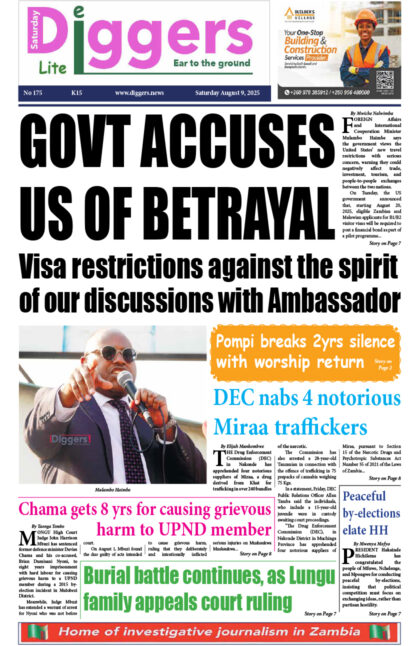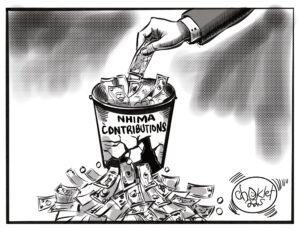“I AM not responsible for the debt crisis. I ran the economy very well under the difficult circumstances. I made my own contribution. I tried to prevent financial irresponsibility and so on,” says Mr Alexander Bwalya Chikwanda in reaction to a letter authored by his predecessors addressed to the President and the incumbent Minister of Finance on Zambia’s debt position.
Is the retired senior citizen being sincere? Is he now distancing himself from the excessive borrowing that Zambia was subjected to under his reign. As Minister of Finance, all the loans that the PF government procured between 2012 and 2016 have his signature. Therefore, it is our view that Mr Chikwanda cannot distance himself from Zambia’s current debt position.
This is a not a matter of speculation. We have taken time to collect data that shows how many loans this former minister procured in five years. Data shows us that he contracted a total debt of over US$9 billion. Our readers may also find the audio embedded at the bottom of this article interesting.
We are not financial experts, but we are here today with a detailed research that shows exactly the names of the lending institutions, purpose of the loans and the amounts that Mr Chikwanda borrowed on our behalf.
2012
In 2012, government contracted 14 loans amounting to US$1.3 billion broken down as follows:
- US$80.4 million for Kazungula Bridge project, from Africa Development Bank
- US$29.6 million for Kafue-Livingstone Transmission Line from European Investment Bank
- US$50 million for construction of 650 Health Posts, from Export Import Bank of India
- US$12 million for Kalabo-Sikongo-Angola Border project from Saudi Fund for Development
- US$50.2 million for Livestock Development, from IDA (World Bank)
- US$29.4 million for Third Poverty Reduction Budget Support, from IDA (World Bank)
- US$68.7 million for Rehabilitation of Great East Road, from Agence Francaise De Development.
- US$56.4 million for the Kafue Muzuma Victoria Falls Project, from IDA (World Bank)
- US$750 million Eurobond for various infrastructure
- US$36.7 million for Kazungula Bridge Project, from Japan International Cooperate Agency (JICA).
- US$70 million for Itezhi-Tezhi Transmission project, from European Investment Bank
- US$5.4 million for Construction of the Sesheke University, from Africa Development Bank
- US$34.4 million for Itezhi-Tezhi Transmission project, from Africa Development Bank
- US$34.4 million for Itezhi-Tezhi Transmission project, from Agence Francaise De Development
2013
In 2013, government contracted 13 loans amounting to US$1.24 billion broken down as follows:
- US$175.9 million for construction of the Mansa–Luwingu Road, Mansa township roads, from China Development Bank.
- US$196 million for upgrading the Mbala – Nakonde Road, from Exim Bank of China.
- US$49.8 million for Agricultural Production Programme, under the SAP International Development Association.
- US$295.8 million for Rehabilitation of Urban Roads, from EXIM China.
- US$18.2 million for Livestock Infrastructure Support Project, form African Development Bank.
- US$183.2 million for Lusiwasi/Lunzua Hydropower Stations, from EXIM China.
- US$50.9 million for Water Resources Development Project, from International Development Association.
- US$107.8 million for Lusaka Transmission and Rehabilitation Project from International Development Association.
- US$20 million for Modernisation of the University Teaching Hospital, from Saudi Fund for Development.
- US$10 million for Construction of Three Technical Colleges, from OFID Fund.
- US$20 million for Procurement of Fertilizer, from Saudi Fund for Development
- US$103.1 million for Rehabilitation, expansion of Mulonga Water and Sewerage, from European Investment Bank.
- US$17.5 million for Climate Resilience in Kafue Sub-Basin, from African Development Bank.

2014
In 2014, Government contracted 9 new loans amounting to US$1.57 billion broken down as follows:
- US$20 million for Teachers Training College NWP, from Kuwait Fund for Arab Economic Development.
- US$15.2 million for Science and Technology Education Project, from African Development Fund.
- US$21 million for Rural Finance Expansion Programme, from International Fund for Agricultural Development.
- US$45 million for Kariba North Bank from Export Import Bank of China.
- US$306 million for Kenneth Kaunda International Airport – Loan 1, from Export Import Bank of China.
- US$54 million for Kenneth Kaunda International Airport – Loan 2, from Export Import Bank of China.
- US$54.4 million for Zambia Water and Sanitation Project, under Agence Française de Development .
- US$70.1 million for Kafubu Water And Sanitation Project, from Nordea Bank Of Denmark.
- US$1 billion Euro Bond – Nkwazi II.
2015
In 2015, Government contracted 12 loans amounting to US$2.21 billion broken down as follows:
- US$15.5 million for Rural Water Sanitation Phase II from African Development Bank.
- US$22.4 million for Lake Tanganyika Development Project II from African Development Bank.
- US$39 million for Kariba Dam Rehabilitation Project from African Development Bank
- US$418 million for Urban and Township Roads, from China Development Bank.
- US$86.7 million for Zesco Lusaka Power Transmission Project, from European Investment Bank.
- US$65.5 million from Smart Zambia Phase I Project, from Export Import Bank Of China.
- US$1.25 billion Euro Bond III.
- US$12 million for Smallholder Livestock Project, from International Fund For Agricultural Development.
- US$52.5 million for Health Service Improvement Project, from International Development Agency.
- US$75 million for Kariba Dam Rehabilitation, from International Development Agency.
- US$14 million for National Rural Water Supply Project, from OPEC Fund For International Development 14.00
- US$163.9 million for Supply, Delivery, Installation of Security Equipment, from Poly Technologies Inc
2016
In 2016, Government contracted 24 loans amounting to US$3.45 billion broken down as follows:
- US$50 million for Chinsali-Nakonde Road Rehabilitation, from African Development Bank.
- US$50 million for Lusaka Sanitation Program, from African Development Bank.
- US$30 million for Supporting Women and Youth, from African Development Bank.
- US$45 million for Cashew Infrastructure Dev Project, from African Development Bank.
- US$29.5 million for Mansa – Luwingu (M3) Amendment, from China Development Bank.
- US$178.5 million for Public Security Network III, from China Development Bank.
- US$170 million for Solar Powered Milling Plant, from China Development Bank.
- US$127.5 million for Lusaka-Kafue Bulk Water Supply, from EXIM CHINA.
- US$337.6 million for Ndola Airport from EXIM CHINA.
- US$ 312.8 million for Phase II Of Urban Roads In Lusaka, from EXIM CHINA.
- US$ 72.6 million for Acrow Bridges Project, from EXIM USA.
- US$8.7 million for Acrow Bridges Project, from Citi Bank Zambia.
- US$169.6 million for Nkana Water and Sanitation, from Industrial Commercial Bank of China.
- US$135.8 for Chinsali General Hospital Project, from million Industrial Commercial Bank of China.
- US$274.6 million for Housing Units Project, from Industrial Commercial Bank of China.
- US$65 million for Girls Education And Women Empowerment, from World Bank.
- US$45 million for Tuberculosis And Health Systems Support Project, from World Bank.
- US$65 million for Lusaka Sanitation Project, from World Bank.
- US$35.8 million for Supplies To Zambia Police from Paramount Ltd.
- US$223.1 million for Kala Baraks from Investec.
- US$24 million for Chinsali General Hospital Project, from Standard Chartered Bank.
- US$449 million for Kafulafuta Water, from Standard Chartered Bank.
- US$29.9 million for Nkana Water Supply Project Phase II, from Standard Chartered Bank.
- US$50 million for Ndola City Roads, from Polytechnologies.
- US$47.1 million for Supplies of ZNS Uniforms, from Africa Security Academy.
- US$60 million for Procurement of Unmanned Aerial Vehicle, Upgrade of Atmos Track, from Israel Discount Bank
The cumulative total of money borrowed over the above five-year period under Mr Chikwanda is US$9.8 billion, and the former minister is welcome to point out which of the loans we have listed he did not sanction.
So now we ask our readers; is it fair for Mr Chikwanda to distance himself from all the above listed loans which he contracted on our behalf? The second question we need to ask is where did all this money go? People would be interested to know how money borrowed for Sesheke University was utilised.
How govt loans were used for PF campaigns
We have outlined all the official loans that Zambia contracted between 2012 and 2016. Our research data shows that during the period under review, the current Patriotic Front chairman for finance, Mr Alexander Bwalya Chikwanda, was responsible for contracting more than US$9 billion external debt on behalf of taxpayers.
If Zambia today is in a desperate financial crisis with US$11.2 billion in external debt, it has been demonstrated that there is one person who cannot distance themselves from this crisis, and that is the PF Central Committee Chairman for Finance, Mr Chikwanda. When the former Bank of Zambia Governor, and former finance ministers wrote to the President of the Republic of Zambia and his incumbent Minister of Finance, giving advice on what government could do to come out of this crisis, there is one person who should not describe that advice as nonsensical, and that’s the PF Central Committee chairman for Finance, Mr Chikwanda.
We are saying, there is a very good reason why the incumbent Finance Minister Dr Bwalya Ng’andu must listen to his predecessors like Ng’andu Magande and Situmbeko Musokotwane. Our research went a little further to look at how much government borrowed under the two past ministers.

In 2007, under Magande, government contracted six loans amounting to US$140.2 million. In 2008, President Levy Mwanawasa died in the middle of the annual budget cycle, meaning we had a new finance minister taking over from Mr Magande to implement the remainder of the cycle from November 24, and thus Mr Musokotwane. Ministry of Finance data shows that in the whole of 2008 government procured five loans only, amounting to US$132 million. In 2009, Musokotwane contracted seven loans amounting to US$233.3 million.
We are not here to eulogise these former ministers who are advising government today. They, too,have their own skeletons in the closet. We have not forgotten how they contracted a US$53 million Chinese loan to buy helpless mobile hospitals. We have not forgotten how government under them procured 100 hearses from China, to escort taxpayers to the grave. But the debate today is about who is responsible for the reckless borrowing that has crashed Zambia in this debt mountain.
Our research shows that between 2007 and 2009 government borrowed US$0.5 billion under these two ministers whose advice is being described as nonsensical today. Compare and contrast that with how much Zambia borrowed in 2016 alone. How can we believe that a man who borrowed US$3 billion in one year tried to stop financial irresponsibility? We don’t mean to be rude to ba shikulu ba Chikwanda, but if this is not reckless borrowing, then he must tell us what is. To us, it does not make sense to claim that you pushed for fiscal discipline yet you went out to borrow more whenever the country ran out of money to waste.
The PF argues that there is nothing wrong with borrowing as long as it is for a good purpose, and we agree absolutely. But can they explain to the taxpayers of this country, what is the return on investment for all these loans? Can they show us how much profit we’ve generated from the Eurobond money invested in Zesco and Zambia Railways? We are saying it’s better NOT to borrow if you don’t have a profitable plan with the money, than to borrow and plunder the money through corruption, leaving substandard infrastructure for political expediency.
You claim to have built infrastructure, that’s okay. But your tax revenue base has not increased as a consequence of those loans you borrowed. You didn’t think about investing in the productive sector so that you use the profit to build infrastructure like police houses and roads. Now you have to pay back the loans plus interest from the same tax revenue sources as before. Does that make economic sense?
Look at the loans contracted in 2016. A whooping 24 loans, amounting to US$3.4 billion. Look at the 72 loans contracted between 2012 and 2016. How much of that money was spent on its intended purpose? We borrowed US$80.4 million from AfDB for the construction of Kazungula bridge and another US$36.7 million from JICA for the same purpose. But the news from Kazungula is that the contractor had to suspend work because Zambia was not paying its share of the cost. Where did the money go? We borrowed hundreds of millions of dollars for the Kariba North Bank, but Zesco is reducing in generation capacity instead of increasing. How many unemployed citizens benefitted from the hundreds of million borrowed under “Youth and Women” empowerment loans?

Remember how the PF presidential candidate went round the country to launch fake investment projects in 2016, like the reopening of Mulungushi Textiles in Kabwe? That is the same way that they acquired loans that ended up as campaign expenditure for the ruling party. From our research data, one can tell that some of the loans that the PF government contracted in 2016 were for campaigns. Some of the projects mentioned in the loans never even took off, meaning the money was diverted towards unaccounted for expenditure.
We will end by reminding readers about this leaked audio recording from 2016, where a Finance Minister discusses cash transactions for campaigns with the secretary general of the ruling party.
Take a listen:
Rewind and listen again until you form your own opinions about the source of the money which was being discussed here.

























7 responses
A thieving lot
Great article. This is how it ought to be. Shame the lairs with accurate data. I don’t think he is so too old to be losing his memory.
Mmmmmmmmmm just how does he manage to do that… this is witchcraft
The devil or the spirit of death is much, much better and holy than the PF GOVERNMENT AND ITS PARTY.
How else can one discrbe this kind of borrowing and spending?
Really this is what Chishimba kambwili calls INSETIABLE APPETITE FOR BORROWING.
My heart is broken no mutwe wakalipa after reading this revelation.
Bushe is it so hard to tell the people of Zambia ukutila, Awe twafilwa we ‘re calling for elections so that others can can take over from where we have left.
Before HIPC loan forgiveness, Zambia was a classic basket case. The loans that we failed to repay in 2000s were a fraction of this humongous debt and now we are back to where we were in 2001. Since insanity is doing a task repeatedly in the same way while expecting different results, in future we should demand as citizens that those appointed to all ministerial and permanent secretary level together with those who appoint them MUST be subjected to rigorous test for schizophrenia to avoid this kind of a mess.
Zambian need to smell the coffee and wake up. It is irresponsible to continue on the road of borrowing and investing project than do not benefit the poor man on the street. The former Finance Minister is responsible for the borrow and cannot distance himself from the national debt. He was in charge on the finances of the country and as the evidence shows, his signature is on the loan agreement which legal binds Zambia to that debt. If he is now saying that he had no part, then it raises serious concerns about what he was doing and the people that put him in that position of authority. It is also sad that we do not have a justice system that can prosecute such individuals for financial mismanagement and bar them from ever holding office and/or running an organisation.
First of all, the people who voted sata and pf are to blame for falling for his 90 days more money lies which were sold and approved by the post newspaper. Even though deep down fred membe new that sata was not fit to be President, for his own personal selfish reasons he wrote articles in his paper to paint mmd bad and sata and pf as saviours for the country. I myself didnt fall for this and i voted mmd because i knew that sata was not fit to be President. I didnt support rupiah banda for his corruption but because he was still following the policies of mwanawasa which had brought the country to prosperity in his own way. Once sata was voted popularly in office, he brings in chikwanda as finance, the same person who failed in the 80s. I have always maintained that the mess in the country we see today, the seeds were sowed as soon as sata was voted in. All eurobonds and most loans were signed by satas pf and chikwanda in particular.